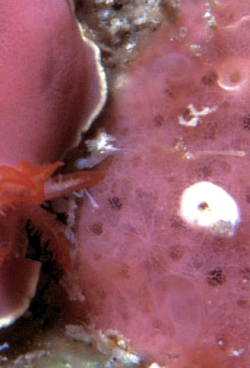Re: Noumea verconiforma? from South Africa
November 21, 2008
From: Scott Johnson

Concerning message #22031:
Hi Bill,
I hadn't picked up on this until you posted Colin Ogden's photo from South Africa, but I think one of my unidentifieds from the Marshalls might be your Noumea verconiforma. Attached are three shots of two specimens found on the same reef but not together (in fact, they were found on successive days and put together for the photo). Both were on the pink sponge visible in the photos. The image of the single individual shows it in its original position under a rock at a depth of 5 meters on 5 September 1983. The next day, when I took the first animal back out to take more photos, I found the second, smaller one on the pink sponge colony in the two photos that show both specimens. My radula drawings show teeth very similar to your SEMs on the fact sheet, particular the shape and denticulation of the wide innermost tooth. The larger animal measured 11 x 6 mm at rest and 16 x 5 mm stretched out and crawling, while the smaller was 9 x 5 mm. It is always a treat to get a probable id for a long-term puzzle.
Locality: Enewetak Atoll, 2-5m, Marshall Islands, Pacific, 5 and 6 September 1983, Under rocks on shallow reef. Length: 9 to 16mm. Photographer: Scott Johnson.
There are a couple of different photos and a bit more information at http://www.underwaterkwaj.com/nudi/chromodorids/e363.htm on the Marshall Islands sea slug web site.
Thanks,
Scott
uwkwaj@yahoo.com



Dear Scott,
Thanks for these. I can't say I have solved your puzzle because I am not 100% convinced they are all N. verconiforma. Certainly the reticulate pattern on the mantle, reminiscent of a fibrous sponge, links them all together, but it may just be that several species have evolved the same camouflage strategy as their namesake Verconia verconis.
Having said that, your photos show traces of the large ovate, opaque white, mantle glands forming a spaced row around the mantle skirt some distance from the edge. My original specimen, and all the other 'possibles' on the Forum have that same arrangement.
The pink sponge, which looks like a darwinellid, would seem to be its food. I'll get its identification checked.
Best wishes,
Bill Rudman
Related messages
-
Noumea verconiforma? from South Africa
From: Colin Ogden, November 14, 2008 -
Noumea verconiforma from Heron Island
From: Julie Marshall, August 30, 2007 -
Noumea verconiforma found in sthn Queensland
From: Gary Cobb, August 30, 2007
